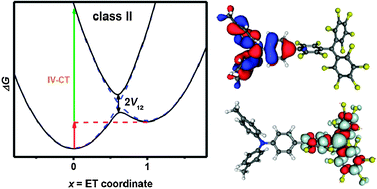Computational and spectroscopic studies of organic mixed-valence compounds: where is the charge?†
Abstract
This article discusses recent progress by a combination of

* Corresponding authors
a
Technische Universität Berlin, Institut für Chemie, Theoretische Chemie, Sekr, C7, Straße des 17, Juni 135, 10623 Berlin, Germany
E-mail:
martin.kaupp@tu-berlin.de
b
Institut für Organische Chemie, Universität Würzburg, Am Hubland, 97074 Würzburg, Germany
E-mail:
lambert@chemie.uni-wuerzburg.de
c Wilhelm-Conrad-Röntgen Research Center for Complex Material Systems, 97074 Würzburg, Germany
This article discusses recent progress by a combination of

 Please wait while we load your content...
Something went wrong. Try again?
Please wait while we load your content...
Something went wrong. Try again?
M. Kaupp, M. Renz, M. Parthey, M. Stolte, F. Würthner and C. Lambert, Phys. Chem. Chem. Phys., 2011, 13, 16973 DOI: 10.1039/C1CP21772K
To request permission to reproduce material from this article, please go to the Copyright Clearance Center request page.
If you are an author contributing to an RSC publication, you do not need to request permission provided correct acknowledgement is given.
If you are the author of this article, you do not need to request permission to reproduce figures and diagrams provided correct acknowledgement is given. If you want to reproduce the whole article in a third-party publication (excluding your thesis/dissertation for which permission is not required) please go to the Copyright Clearance Center request page.
Read more about how to correctly acknowledge RSC content.
 Fetching data from CrossRef.
Fetching data from CrossRef.
This may take some time to load.
Loading related content
